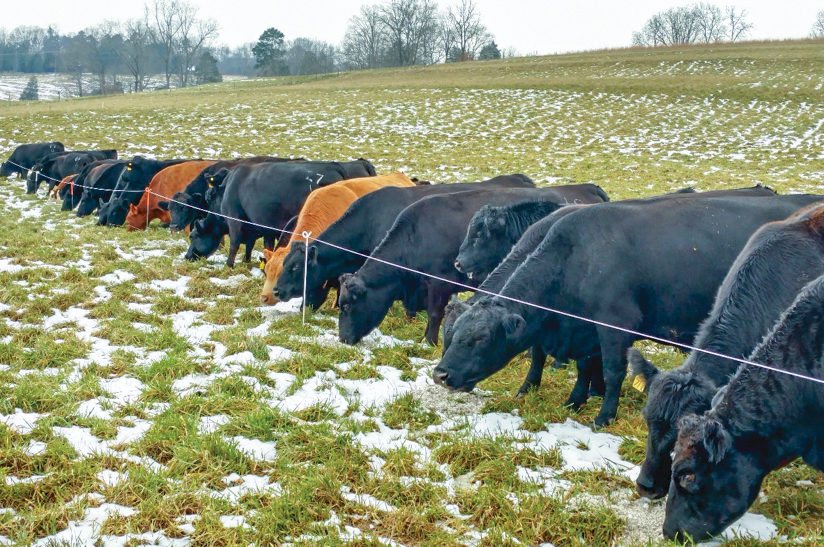Fence management
The traditional non-electrified options have to create a physical barrier, which animals continually lean on, and reach through and over, putting strain on the corners and stretching the wire. As a result, non-electrified fences are much higher in both construction and maintenance costs.
While many farmers have adopted electric perimeter and cross fences, relatively few routinely use temporary electric fence technology. When I discuss this with farmers, many tell me they just don’t have time to put up and take down temporary fence. Others say they have tried it, but either deer or the livestock tear the fences down frequently, so they quit using it.
As a 40-year user of temporary fence, I can’t imagine how we could manage our place without it. We have used temporary fence so long the cows are very well-trained, and we rarely have them break out. While I will talk mostly about cattle, the same concepts apply to other grazing livestock.
If you have not used temporary fence, or have tried it and had problems, understanding a few basics will help you. The most important thing to keep in mind is it takes a lot of power. Experience has shown a low level of power (or none at all) can work with a multistrand high-tensile perimeter fence, but low power will not work with single strand temporary fence.
To successfully implement temporary fence, the first step is to make sure there is plenty of power. You need to make sure it has at least 5 kilovolts under good conditions. Less than this and you will see low power problems in wet weather or other challenging conditions. Actually, cattle are well controlled at 3 kilovolts, but remember, you need to be training your deer and other wildlife too.
A key step is to make sure your animals are well-trained. If they encounter a single strand temporary fence and are not trained, they will likely tear it down. We suggest using a small “training pasture” with the temporary fence about 3 feet off the perimeter.
This will give the animals a chance to experience the fence without running through it. It will only take a few days to train them, and after they understand what it is you can begin to cut pastures in half with temporary fence. It is critical to keep a lot of power during this step so they are strongly reinforced each time they contact the fence. It is common to see animals tear down the fence at this stage because they are still learning it, but watch them closely and put it back up immediately.
Next you can start doing some “strip grazing”, giving them strips with just a day of grazing. This will get you around the animals frequently, and they will get into the rhythm of frequent allocation and will get used to being close to you. They will be grazing close to the wire during this time, and they will begin to understand they can reach under the wire and will get very careful not to touch it. At this point, you might find an animal or two which just does not get it and will not stay in. A little culling at that point will go a long way.
Troubleshooting
Each time you have a failure in the temporary fence, evaluate what happened, learn from the experience, put it back up and keep on. You will find by making the fence straight and tight and using a driven post, you can easily pull and move it for corners or to stabilize the ends, which really helps until the animals are well-trained (I like 7/8” x 60” UV- stabilized fiberglass).
Test your fence power regularly. If you have trouble keeping enough power, you might need a more powerful energizer to make the temporary fence work. Also, as you get to longer and longer stretches of fence, you may notice the power drops as you go out along the fence. Having the needed 5 kilovolts at the source end of the temporary fence is not hard, but you still need that much at the other end too.
Inexpensive polywire is really designed for very short runs, so if you have long runs you need to get wire or tape with more strands (nine strand versus six) or you can go to a “mixed metal” polywire or polybraid which has much lower resistance and therefore will keep power much higher at the end of a long run.
Given the importance of keeping a high level of power, you need to invest in a fence fault finder which can tell you not only voltage, but also how much power is flowing past you through the fence. This helps you find shorts and keep the power high without having to walk blind looking for a short which is often hidden.
Other advantages to a temporary fencing system
Once your herd is well-trained and you have mastered keeping the power high, you can start to enjoy the other benefits of the system. My colleague Johnny Rogers calls this the “Power of One Wire,” and there are a lot more benefits to it than just improving grazing distribution and forage utilization. When animals are well-trained, it makes them a lot easier to work with.

A reel of polywire becomes a tool in gathering animals, sorting animals, and even getting them easily into a trailer or reducing the number of workers needed in the working pen. Two good hands with a reel can get an ailing cow out of the herd and take her to the working pens without any of the normal running, whooping and hollering. Even though there is no power on the wire you are using, well-trained cows don’t know this and will not challenge it.
Additionally, when you have a critical need for fencing, such as after a storm which damages your fences, having animals who respect temporary fence means you can implement temporary repairs quickly and effectively until permanent repairs can be made. Occasionally we also need to protect “sensitive areas” such as an erosion spot or a stand of trees which needs a rest from the livestock, or we simply need to create a temporary lane to move cattle from one field to another. Again, having well-trained animals makes all these activities successful.
Temporary fence technology is too important not to be seriously considered on a grazing farm. If you have not used it, study the principles and give it a try. If you have abandoned it, study the principles and try it again. When I consider everything it does for us on my home farm, I continue to believe we could not stay in business without it. To learn more, visit our website, which you can find by searching “Amazing Grazing and CEFS.” There you will find more detail on “The Power of One Wire” and the “Twelve Steps to Amazing Grazing.” ![]()
PHOTO 1: Cows graze stockpiled fescue and are fed whole cottonseed under polywire.
PHOTO 2: “The Power of One Wire” is used in the working pen. Photo provided by Matthew Poore.

-
Matt Poore
- North Carolina State University
- Email Matt Poore








